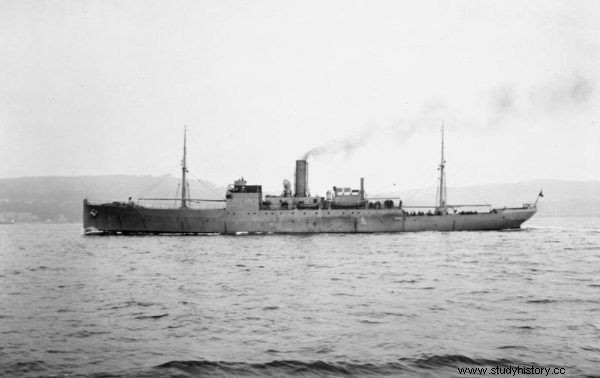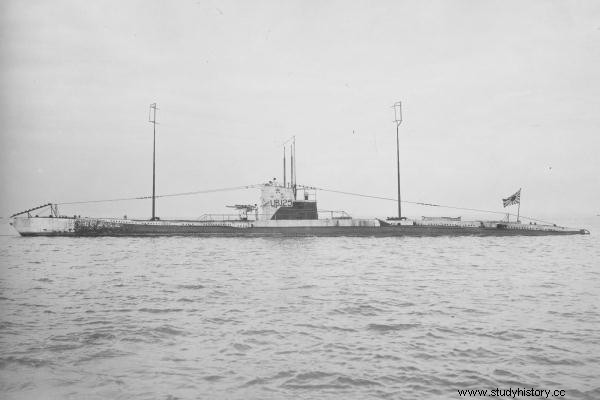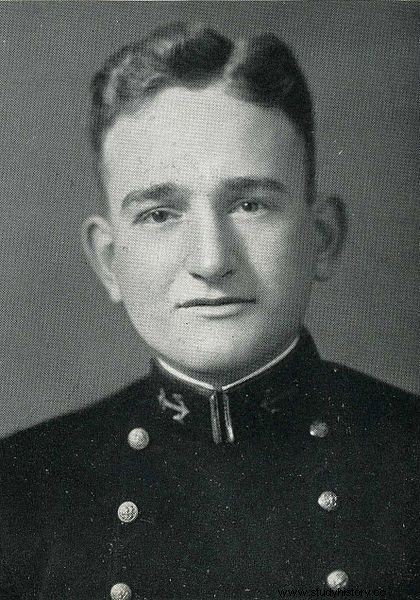The commander felt as if something monstrously heavy had landed on the starboard. He looked up at the deck and - as if in horror - saw a huge sea creature trying to climb onto the ship. What caused the sinking of UB-85? Did the cousin of the famous Loch Ness monster have a tail in it? And what role did ... the radiator play in this mysterious affair?
On patrol
The North Channel, which connects the Irish Sea with the Atlantic Ocean, has always been a rich hunting ground for pirates hunting there. At its narrowest point, it is only 20 km wide.
On April 30, 1918, a special "pirate" hunted there early in the morning - the German U-Boot UB-85. He had been patrolling the waters of the Irish Sea for two weeks now to "release" one of his ten deadly torpedoes. Unsuccessfully! A frustrating void stretched all around him. It is worth noting that in April 1918 the U-Boats took a heavy harvest of 280,000 tons of Allied ships. The commander of UB-85 Günther Krech made it a point of honor to add to this result also some of his "gains".
In order not to miss the opportunity for the attack, the commander stood on watch and personally surveyed the horizon line through binoculars. The peace of the ship was suddenly disturbed by a violent shock. Krech felt as if something monstrously heavy had landed on the starboard. He looked up at the deck and - as if in horror - saw a huge sea monster trying to climb onto the ship. This is how he described it later:
The monster had incredibly large eyes and a calloused skull. The head was relatively small, but the teeth were large and glistened in the moonlight. Whoever could, he started firing at him, but he settled right in front of our front gun and didn't feel like moving.
Consequences of the meeting
The monster's weight was so great that it began to drag a 730-ton submarine into the water. The biggest problem was that the hatch to the kiosk remained open, which was a lethal threat. Krech continued to order the crew to fire. Finally, as a result of successive hits, the monster gave up "hugging" the ship and disappeared into the sea. The crew breathed a sigh of relief. As it turned out, prematurely.
The joy on board was short-lived! It soon became apparent that the date with the creature was not without consequences. Due to the damage caused by its enormous mass, the ship was unable to submerge. Fully aware of the threat, the seafarers henceforth felt like a "duck on fire".

A photo of the British Anchusa class HMS Coreopsis.
Suddenly, a British ship appeared on the horizon - it was Coreopsis. The British, ready to fight, must have looked surprised when they approached the U-Boat and… saw its crew standing on the deck with their arms raised. After taking over the Germans, the British sunk UB-85, and with it ... all the evidence that could help verify the amazing story about the sea monster . However, can the story presented by Krech be credible at all? Not really…
Unexplained mystery
In October 2016, Scottish Power encountered an unidentified wreck during work related to the installation of cables on the seabed. Its position was in line with that given by Coreopsis in 1918, so it could have been the legendary UB-85. Although historians also took into account the sister unit UB-22, also sunk in the area, but later analyzes dispelled doubts - it was in fact UB-85!
Sonar research has shown that there is an object on the seabed at a depth of 103 meters, the size of which corresponds to a German submarine. However, on the basis of the photos, it was not possible to notice the potential damage to the deck, which would indicate an attack by a sea monster. Nevertheless, the old tales suddenly revived. Gary Campbell, who keeps track of the official Loch Ness Monster data, said:
The area where the wreck was found is known from earlier sea monster stories. So what the captain was talking about might have been true. It is great that we have information about the sea cousin Nessie, who additionally joined the hostilities on our side.
So what sank the UB-85? The mysterious incident did not leave too many traces. Commander Krech died of unknown causes in March 1919 at the age of only 33. The US archives may have been the only way to solve the mystery. The problem was that the topic of World War I U-boats took up 4,317 rolls of microfilm! Retired San Diego Detective Dwight Messimer has taken on the challenges of tracing the history of ships. It is thanks to him that we can get to know the memories of the UB-85 crew today.
The Shocking Truth
And so, for example, the navigator reported after the fact:
Krech ordered an emergency draft after spotting a British patrolman. The hatch of the kiosk was closed, but when we found ourselves under the water, a huge flood fell on us through this hatch.
Therefore, we know that UB-85 had problems with the hatch, which posed a lethal threat to it. Water rushing on board caused the failure of pumps, batteries and electric motors. There was a dangerous chlorine in the air, which appeared as a result of flooding the batteries. The crew was in a double danger - they were in danger of drowning or poisoned by chlorine fumes.

Twin unit UB-85 - SM UB-125
The commander had no choice but to order immediate ascent. Knowing that they could be fired upon by a patrol boat after reaching the surface did not help the sailors in this horrible situation. Let us give the floor to another crew member - Julius Göttschammer reported:
We opened the door to the control panel and started walking towards the hatch. We had to overcome strong streams of water breaking onto the deck.
His further memories are crucial to solving the mystery. He claimed that Krech had installed a radiator in the commander's cabin! This installation required routing the cable through the switchboard. This cable ran through the turret, which meant that it could not be completely sealed. According to Göttschammer, this was the reason for getting on the water. If not for the cable, only the kiosk would be flooded.
When the U-Boat was afloat, it actually came under British fire. The Germans were unable to take up the fight as their ammunition was in a flooded compartment. This, moreover, explains their passive attitude just after surfacing!
The last to leave the U-Boat were Krech and the navigator, who additionally opened the valves so that the ship would not fall into enemy hands. With him, all documents and code books went down. Thus, it can be jokingly stated that the primary cause of the sinking of the U-Boat was to keep the commander's feet warm, not a sea monster. With his story, Krech, however, covered up the fatal circumstances of the loss of the U-boat.
Face the monster
It wasn't the only time I had encountered a mysterious creature at sea (though it wasn't necessarily the same monster!). On July 30, 1915, the British freighter Iberian was torpedoed by U-28 in North Atlantic waters. It sank so quickly that its beak fell almost vertically under the water. After about 30 seconds from sinking, an underwater explosion occurred on the wreckage. The remains of the freighter took to the air and it would not be surprising, if not for the fact that among them ... a huge sea monster, the force of the explosion blasted to the surface at a height of about 25 meters. The commander of the U-boat Freiherr Georg-Günter von Forstner described the event as follows:
At one point I was at a kiosk with six people. Among them was the chief mechanic and navigator. We all paid close attention to something strange that appeared between the wreckage.
None of us were able to properly identify this creature - it looked a bit like a crocodile, except that it was about 20 meters long. This thing had four legs ending in webbed paws, a long tail, and a big, pointed head . Unfortunately, we were not able to photograph this freak, as after 10 seconds it was underwater again.
Mustache Sea Creature
Similar close encounters also took place during World War II.
American submarine ace George Grider was one of only seven American commanders to underestimate their achievements. Grider reported six hits to HQ when he actually sank seven ships. 70 other US submarine commanders showed overstated successes. For example, William Post reported a total of 19 sinkings, of which proved to be reliable ... 8. For the sake of rectification - the same happened in the German U-Bootwaffe. Commanders of underwater weapons were not always able to properly verify the effects of their attacks.

Grider added in his report that the monster's color had a shade of such intense green as he had never seen before.
What is important, however, is what Grider wrote in his post-war memoirs. So let's give him the floor:
I picked up the periscope and watched the fairly clear water while it was still several meters under the water. It was extremely rare to have the opportunity to observe sea creatures, as the ship's kiosk effectively scared away everything around. This morning I had the opportunity to observe a real sea monster. He was all green! It had a large head, at least in proportion to the rest of its body, a long, fibrous mustache that waved just as he lazily approached the periscope. His sinister eyes were staring right at me!
Grider added in his report that the color of the monster had a shade of such intense green that he had never seen before. The commander denied it was a huge fish and referred to "it" as a ... sea monster! Believe? Do not believe?
